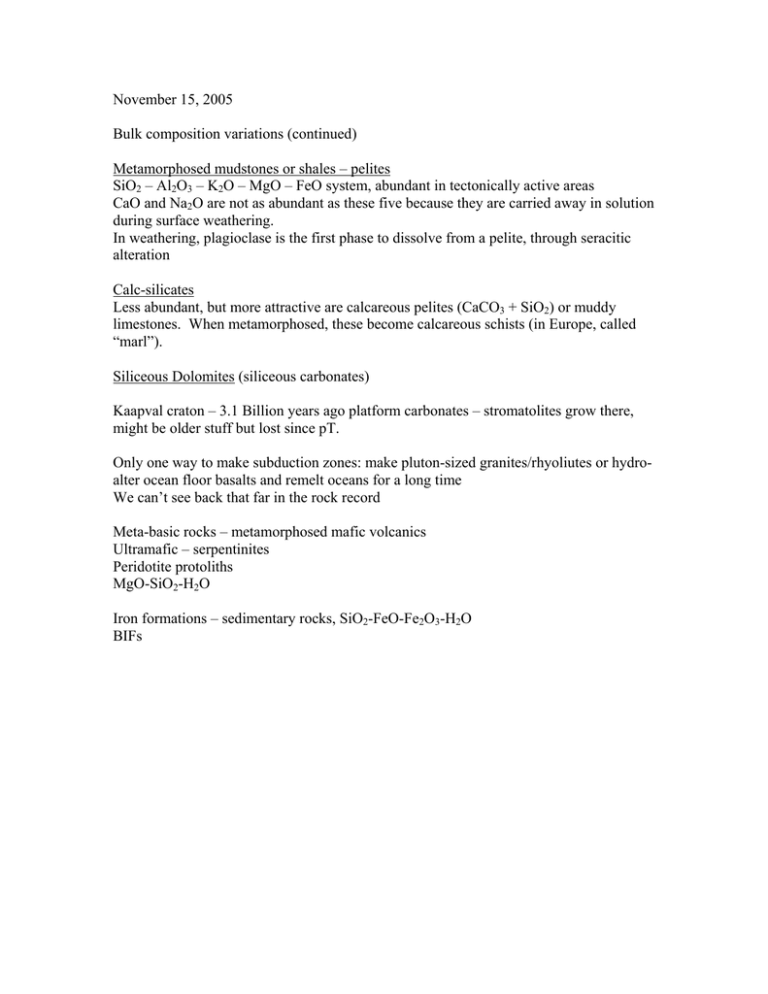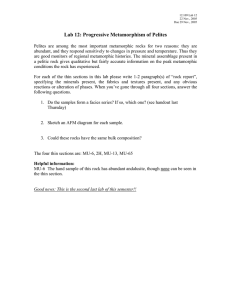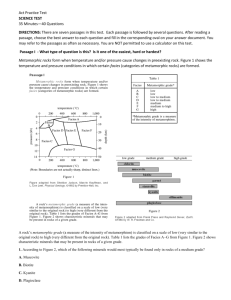November 15, 2005 Bulk composition variations (continued)
advertisement

November 15, 2005 Bulk composition variations (continued) Metamorphosed mudstones or shales – pelites SiO2 – Al2O3 – K2O – MgO – FeO system, abundant in tectonically active areas CaO and Na2O are not as abundant as these five because they are carried away in solution during surface weathering. In weathering, plagioclase is the first phase to dissolve from a pelite, through seracitic alteration Calc-silicates Less abundant, but more attractive are calcareous pelites (CaCO3 + SiO2) or muddy limestones. When metamorphosed, these become calcareous schists (in Europe, called “marl”). Siliceous Dolomites (siliceous carbonates) Kaapval craton – 3.1 Billion years ago platform carbonates – stromatolites grow there, might be older stuff but lost since pT. Only one way to make subduction zones: make pluton-sized granites/rhyoliutes or hydroalter ocean floor basalts and remelt oceans for a long time We can’t see back that far in the rock record Meta-basic rocks – metamorphosed mafic volcanics Ultramafic – serpentinites Peridotite protoliths MgO-SiO2-H2O Iron formations – sedimentary rocks, SiO2-FeO-Fe2O3-H2O BIFs Metamorphic facies + isograds 1. Isograds Barrow – mapped metamorphic rocks in Scotland, recognized zones of progressive metamorphism – based on pressure of index minerals Boundaries between zones marked by the appearance of each index mineral Pelite sequence: chlorite Æ biotite Æ garnet Æ staurolite Æ kyanite Æ sillimanite See in field: Chlorite zone | Biotite zone, etc. Boundaries marking the appearance or disappearance of minerals between zones were called isograds. Isograd – “equal grade” – intersection of a surface of equal P&T with the ground topography Appearance depends on P, T, fluids, and the bulk composition of a rock Barrovian metamorphism – classic example of middle P-T conditions (usually in orogenic or tectonic setting) 2. Facies Eskola (1910-20, later than Barrow) – recognized a distinct set of mineral assemblages that were characteristic of a set of P-T conditions – metamorphic facies This got complicated because of the large number of named facies. Fortunately, people stopped naming new facies. In common use now: Barrow’s zones Biotite Garnet Staurolite Staurolite-kyanite Sillimanite Mafic rock facies Greenschist Epidote-amphibolite Amphibolite Pyroxene granulite K-feldspar Calc-silicate rock facies Talc-phlogopite Tremolite-actinoliteepidote-zoisite Diopside-grossularscapolite Forsterite Plate Tectonics + Metamorphism Miyashiro – worked in Japan in 1950s, most famous Ryoke belt – discovered new types of metamorphic rocks Metamorphic belts were recognized that recorded contrasting P-T conditions Al2SiO5 triple point @ 3.5 kbars, 500ºC 1 kbar ≈ 3 km in mantle, 4 km in crust 105 Pa = 1 atm Types I. II. III. Zeolite Æ prehnite-pumpellyite Æ blueschist Æ eclogite Barrovian Low P, high T sequence – andalusite Æ sillimanite Æ greenschist Æ amphibolite In the 60s when plate tectonics were recognized, it became clear that these zones represented different parts of the subduction environment I – characteristic of subducted oceanic lithosphere III – characteristic of the active volcanic arc Interpretation 3. how do isograds and mineral assemblages record changes in P and T? system – CaO – Al2O3 – SiO2, 3 components, phase rule F = c + 2 – φ F = # degrees of freedom c = # components 2 = T and P φ = # phases so F = 5 – φ if F = 0 (no degrees of freedom, invariant point), 5 phases coexist at aluminosilicate triple point, 3 of those phases are the three isomers of Al2SiO5







